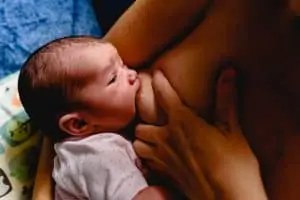If your boobs hurt when you’re breastfeeding, something isn’t right. That’s why I want all you new mamas out there to learn about the deep latch with a newborn, a technique that will ensure the baby gets that precious milk and you stay free of pain.
A deep latch with tongue tie is possible too. I have deep latch breastfeeding tips and am including a deep latch technique video to help you be successful here.
How do you get a deep latch when breastfeeding?
I’m going to direct you to this illustration here. I want you to look at the 4 frames and read the tips along with them, so you get a visual to go with it.
![How to Succeed at Deep Latch Breastfeeding with Tips [Graphics and Videos to Help] step by step how to do deep latch by Kidslymom.com](https://kidslymom.com/wp-content/uploads/2021/11/deep-latch-technique-illustration.webp)
- Nose to nipple
See how the nose is directly across from the nipple? So many mamas start with their baby’s mouth across from the nipple. Shift your baby so she is with her nose to nipple, and you should get that deeper latch.
- Open wide
Now, when you see baby opens her mouth really wide, that’s go-time. Babies will naturally root, opening and closing their mouths and bobbing their head. You may need to be patient to let nature take its course. When you see that mouth open wide, that’s when you bring the baby to your breast. Doing so too early results in a shallow latch.
- Get more than the nipple in
It’s not called nipple-feeding for a reason. That’s because your breast gets in there too. It has to so your baby can push on the milk ducts and get milk moving. In this picture, you can see that the bottom lip should touch the breast at the edge of the areola first to make a deep latch successful.
- Look for fish lips
At the top, it’s easy to see lips flanged out, but underneath, you want to feel to make sure your baby has fish lips. Remember that the lower lip should touch your breast first to get that deep latch. It helps to imagine you have a sandwich. You bring it to your mouth, and your lower jaw touches it first. Breastfeeding is the same. If you feel the lip is inward on the bottom, use a clean finger to flip it out.
If you do it right, you’ll feel a bit of a tugging or pulling when baby nurses, which should never be painful. If you feel pinching, clamping, or any kind of pain while breastfeeding, you’ve got to readjust the latch and try again.
Do you need a bit more direction? There’s a great deep latch technique video that shows you how to do it and explains its reasoning in a relatable way. I love how it speaks to mamas and offers a bit of loving support where you can see and follow again with what’s going on to make sure you’re doing the deep latch with your newborn correctly.
How do I get my baby to open his mouth wider to latch?
Now, you might be wondering about that second step I mentioned above. How in the world do you get a baby to open up wide? Here are some tips so you can get that mouth open big and get the breast in correctly for that deep latch.
- Don’t put the baby into a feeding position until you are ready for latching. Doing so too soon will create a frustrated baby who is already rooting for the boobs.
- Move your baby toward your breast, touch the top lip to the nipple, and then move the mouth away slightly.
- Keep doing this until you see your baby open wide with the tongue forward.
- Also, you can run your nipple on your baby’s upper lip from corner to corner in a light way. This will also result in a wide-open mouth.
How do you get a deep latch laid back?
Actually, the laid-back position for breastfeeding may be an excellent assist for you if you’re having trouble with the deep latch.
![How to Succeed at Deep Latch Breastfeeding with Tips [Graphics and Videos to Help] Young mother breastfeeding her newborn baby boy at home](https://kidslymom.com/wp-content/uploads/2019/02/Laid-back-breastfeeding.webp)
When you are reclined, you are letting gravity do what it naturally does. Often called “biological nurturing,” in the laid-back position, you can get your baby to latch on even more easily because everything falls into place.
Of course, make sure the baby is opening her mouth wide first, but after that, you should be able to get your nipple and areola in there for that deep latch.
How do you get a deep latch in football?
You can get a deep latch with the football position too. A suitable nursing pillow can help you hold her right. You want to put your baby’s feet behind you; otherwise, she may instinctively kick or push off anything she puts her feet on.
Put the heel of your hand onto your baby’s shoulder blades while your fingertips are on her temple. Turn her body into yours and keep her butt tucked in tightly. Now, let your breast hang and move your baby back until your nipple naturally aligns with her nose. Following the illustration, I posted above, continue until you get that latch.
My baby has small mouth, how to get a deep latch?
All babies look funny with a small mouth, often appearing recessed. That shouldn’t stop you from getting a deep latch.
![How to Succeed at Deep Latch Breastfeeding with Tips [Graphics and Videos to Help] mom tries deep latch holding breast as sandwich](https://kidslymom.com/wp-content/uploads/2021/10/Mom-c-holds-deep-latch.webp)
You want to have your baby’s mouth cover most of the bottom part of your areola as well as some of the top above the nipple. This stimulates the milk glands during the suckling to create more milk.
It shouldn’t matter if you have large breasts or your baby has a small mouth (or both!). Simply make a sandwich out of your breast.
Think of how you squish a big sandwich down to get a good bite of it. It’s the same thing except with your boobs.
Cup your breast, so you have it in a U-hold. Keep your fingers parallel to your baby’s lips. Now, squeeze gently, and this creates a smaller thing to bite for babies with small mouths.
I have flat nipples, how to get a deep latch?
Are flat nipples a problem for you? That won’t stop you from breastfeeding. If you have flat nipples before giving birth, you may be glad to know that childbirth and pregnancy itself may cause your nipples to protrude naturally.
But if your nipples are flat after you deliver, you can find many solutions to help you out.
- Try breast shells
These things go inside your bra and can help get inverted nipples to pop out. They’re 2 plastic pieces, with the inner piece having a hold that goes over your nipple. The pressure it creates will make your nipple pop through the hole. You’ll want to wear them about an hour and a half before your feedings.
However, please know you should never wear them at night while you sleep. Keep them clean to prevent contaminating your breasts, and don’t keep any milk you collect while you wear them.
- Use a pump
The breast pump that you use to collect milk for a caregiver to feed your baby or relieve your engorged breasts can help too. This will elongate your nipples right before you breastfeed. Give it a try before nursing, and make sure you clean your breasts off to avoid spreading germs.
- Stimulate your nipples
You can even just stimulate your nipples before you go for feeding time. Roll it between your fingers for a minute. Or try putting a cold cloth on it. This will have your nipples stand up on end.
One thing to remember, though, is if you use ice, be brief. You don’t want it numbing your let-down reflex.
- Try the pull-back
You can also pull-back as you go to breastfeed. With your hand supporting your breast, pull back slightly on your breast toward the chest, so the nipple protrudes.
- Consider a nipple shield
If you’ve tried everything else, a nipple shield may work for you. This thin and flexible tool goes over your nipple. It has holes that let the milk flow out to your baby. However, I don’t recommend doing this by yourself.
If you have trouble getting your nipples to protrude and getting that deep latch, you should consult a lactation consultant or breastfeeding coach to help ensure you’re doing it right. Improper use of a nipple shield can cause other problems, and you’ll want to avoid that.
Other Things to Know About Proper Latch
Additionally, I want you all to know what else to look for, so here are a few more questions I’ve received recently to help you along.
Is my baby drinking my breastmilk?
Watch the lower jaw and around your baby’s ear and temple. You should see movement, which will clue you in.
Another way to know if your baby is indeed drinking your breastmilk is to listen for little clicks that can indicate your baby is gulping. At the beginning of a feeding session, it’s common for babies to suck quickly. Toward the end, they slow down.
Your breasts might feel softer. You will also notice your baby seems more relaxed. Watching for these things will help you see that your baby is getting her milk.
Is baby latched right? How do I know?
![How to Succeed at Deep Latch Breastfeeding with Tips [Graphics and Videos to Help] proper latch](https://kidslymom.com/wp-content/uploads/2019/05/Perfect-breastfeeding-latch.webp)
The first clue you’ll have when a baby isn’t latched on correctly is that it feels uncomfortable. You may feel pain or pinching, which will tell you this isn’t right.
Additionally, babies that latch on wrong will fall asleep on your breast and won’t seem satisfied after they nurse. Please know that it is very common for babies to fall asleep on your boobs at night. Both of mine did. The key here is that your baby always seems to fall asleep on your breast no matter when and that they aren’t seeming satisfied after eating.
What to do about an incorrect latch?
Break the suction. Use your clean finger inserted in between your baby’s lips and your breast. Don’t just yank her from your breast, or it will hurt!
Then, you’ll reposition your baby using the tips I mentioned above. If you’ve tried and tried again and it still hurts, please get in touch with your doctor or your lactation consultant to make sure nothing else is going on that could be causing it.
When should I worry about the latch?
If you can’t breastfeed without pain, you should call your doctor. As for your baby, you should be concerned if she keeps falling asleep at your breast, isn’t satisfied after feedings, doesn’t gain weight, or isn’t making soiled diapers as often as she should.
In general, newborns should make about 6 wet diapers and 4 poop-filled diapers per day. It will get less eventually, but in the newborn phase, seeing lots of wet and poopy diapers is a good indicator you’ve got that latch right.
If anything ever feels off to you, that’s when you call the doctor. I’ll repeat it…breastfeeding shouldn’t hurt. When you have the latch right, you will never be bothered by nursing your child.
I can’t emphasize enough that there should be no shame here. If you aren’t getting a proper deep latch with your baby, get some help for it right away. Many people can help you, and once you have them show you how, you’ll get that latch and always have it.
A good latch is critical for proper breastfeeding. You can learn all about it before giving birth, but the real test is when you try it yourself. I know it seems strange because you haven’t done it before, which is why the experts can lend an assist and get you on the right path with breastfeeding.
Leslie Berry lives with her husband and two young daughters in Los Altos, California, where she loves helping other moms get comfortable with motherhood and embracing the insanity with facts peppered with laughs.
She loves eating too much sushi, exercising, and jamming out on her Fender. Read more about Leslie here.

![How to Succeed at Deep Latch Breastfeeding with Tips [Graphics and Videos to Help] q? encoding=UTF8&ASIN=B07PG7YQ5C&Format= SL250 &ID=AsinImage&MarketPlace=US&ServiceVersion=20070822&WS=1&tag=kidslymom 20&language=en US](http://ws-na.amazon-adsystem.com/widgets/q?_encoding=UTF8&ASIN=B07PG7YQ5C&Format=_SL250_&ID=AsinImage&MarketPlace=US&ServiceVersion=20070822&WS=1&tag=kidslymom-20&language=en_US)





